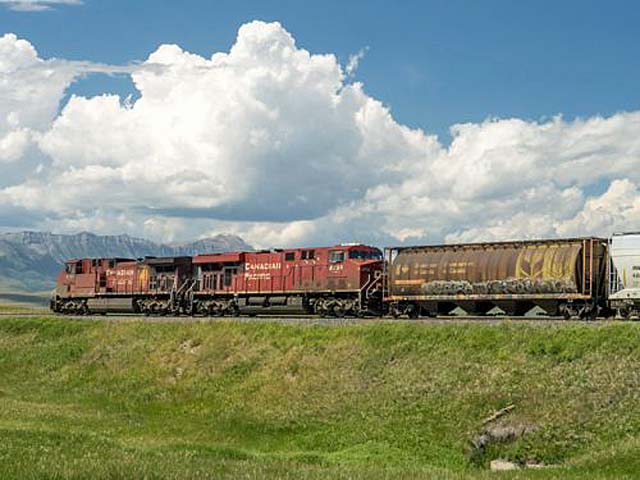
Canadian Pacific Crowsnest Subdivision - Canadian Pacific's (CP) Crowsnest Subdivision is busy with grain trains as prairie elevators are cleared
to accept the coming harvest.
CP has been pairing trains through the subdivision by giving two trains simultaneous clearance, with the on-board conductors responsible for keeping them
safely apart.
The conductor of the lead train reports the train's position mile-by-mile, and the following conductor stays 10 miles or so behind.
The dispatcher is not involved in the conversations.
"The practice is called an "Item 6: Protect Against", which allows a train to follow a preceding train," explains CP spokesman Marty
Cej.
"This practice is commonplace across different railroads in both Canada and the U.S.
In Canada, the Minister of Transport has approved the rules that govern this process.
In the U.S., the procedure is called "Radio Blocking."
It allows one train to follow another into non-signaled territory.
Radio Blocking is covered in GCOR (General Code of Operating Rules (U.S.A.)), as follows:
14.4 Occupying Same Track Warrant Limits
(Track Warrants are call TOPs, Track Occupancy Permits in Canada.)
A track warrant must not be issued to a train within the same or overlapping limits with another train unless:
1. In signaled territory, all trains are authorized to proceed in the same direction.
2. In non-signaled territory, all trains are authorized to proceed in the same direction and are instructed to move at restricted speed.
3. Two or more trains are authorized to "WORK BETWEEN" two specific points at restricted speed within the overlapping limits.
4. Trains are authorized to proceed through the limits of another train authorized to "WORK BETWEEN" two specific points, and track warrants instruct
all trains to move at restricted speed within the overlapping limits. When station name(s) designate the overlapping limits, refer to Rule 14.2 (Designated
Limits) for limits where trains are required to move at restricted speed.
5. Radio Blocking is authorized as outlined by Rule 14.4.1 (Radio Blocking).
Where track warrant authority includes yard limits or restricted limits, the terms of Rule 6.13 (Yard Limits) or Rule 6.14 (Restricted Limits) apply, but track
warrant instructions must be followed.
14.4.1 Radio Blocking
Where designated by special instructions, in non-signaled territory, more than one train may be authorized to proceed in the same direction within the same or
overlapping limits, provided the following train:
- Is notified on the track authority of the identity of the preceding train;
- Does not occupy the limits ahead of the preceding train;
- Notifies the crew of the preceding train that radio blocking has been authorized stating the limits;
- Is notified by the preceding train that the entire train has passed a specific location. Location specified must not be beyond limits indicated. The
following words must be used: "(Train) clear of (location)";
- Does not proceed beyond the last location the preceding train has reported to have passed.
All instructions between the trains must be written, repeated, and acknowledged with "THAT IS CORRECT" before being acted on.
These written instructions between the trains must be retained until the end of tour of duty.
Notify the train dispatcher if communication cannot be established between the two trains.
If necessary, radio blocking information may be relayed only by the train dispatcher.
The last named point of the following train's authority must not extend beyond the last named point of the preceding train's authority.
In the application of Rule 6.4 (Reverse Movements) and Rule 6.6 (Back Up Movements), the movement must not go beyond the last specific location reported to the
following train.
William C. Vantuono.



